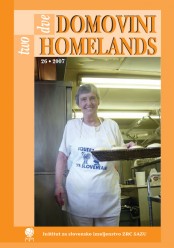Pomen cerkve in verskih kongregacij za slovenske in norveške emigrante v Združenih državah Amerike. Primerjalni vidik
Ključne besede:
emigracija v ZDA, cerkev, verske organizacije, socialno in dobrodelno delo, naselitvene skupnostiPovzetek
Slovenija in Norveška, obe majhni evropski državi, sta bili v svoji zgodovini okupirani. Prva je imela katoliško cerkev, druga luteransko, pri obeh pa so se predniki iz predvsem ruralnega okolja izseljevali v Ameriko v devetnajstem stoletju, četudi v razmiku štiridesetih let. Preučiti razlike in podobnosti med emigranti, ki jih je ustvarila situacija oz. predvsem cerkve, predstavlja izziv. Nedvomno je religija imela vpliv na njihova življenja -slovenska cerkev je bila bolj avtokratična, norveška bolj demokratična. Obe sta sodelovali pri izobraževanju, dobrodelnosti, družbenih in kulturnih aktivnostih, vendar pod različnimi pogoji. Pozitivne učinke je lažje izpostaviti, dolgoročnejši vplivi amerikanizacije pa zahtevajo širšo perspektivo.
Prenosi
Literatura
Bleken, M.K. 1914: De Norsk-Amerikanske skoler (“The Norwegian-American Schools”). In: The Promise of America. Articles and texts. (http://www.nb.no/emigrasjon/emigration/2nd_ar.html).
Canuteson, Richard L.: Lars and Martha Larson: “We do what we can do for them.” In NAHA,Volume 25, page 142. (www.stolaf.edu/naha/pubs/nas/volume25/ vol125_6.htm).
Catholic Encyclopaedia (http://www.newadvent.org/cathen/14042a.htm).
Drnovšek, Marjan, 1992: The Attitude of the Slovene Catholic Church to Emigration to the United States of America before 1914. Slov.stud., vol.14, no 2.
Drnovšek, Marjan, 1994: Mass emigration and Slovenes. Dve Domovini, Two Homelands. No.5.
Drnovšek, Marjan, 2003: Ljubljana and Emigrant Agencies at the Beginning of the Twentieth Century. AEMI Journal,vol 1.
Elizabeth, Fedde, 1888: Diary, Folkedahl, Beulah ed. and translator (www.naha.stolad. edu/pubs/nas/volume20/vol20¬_9.htm).
Durkheim, Émile, 2000: Om den sociale arbejdsdeling ( ”De la division du travail social.”).
Křbenhavn, Reitzels forlag.
Friš, Darko, 1995: Ameriški Slovenci in Katoliška cerkev : 1871-1924. Celovec, Ljubljana, Dunaj: Mohorjeva založba.
Gantar Godina, Irena, 2001: Overview of the Slavs from Habsburg Monarchy to Canada – up to 1918. In: Once a Jolly Swagman…” essays on Migration in Honour of Olavi Koivukangas. Turku, Institut of Migration.
Gjerde, Jon, 1997: The Minds of the West. Ethnocultural Evolution in the Rural Middle West 1830 – 1917. The University of North Carolina Press.
Gordon, Milton M., 1904: Assimilation in American Life. The Role of Race, Religion, and NationalOrigins. New York, Oxford University Press.
Greipsland, Torbjřrn,1997: Drřm og dramatikk i det norske Amerika (”Dream and Drama in the Norwegian America”). Genesis, Oslo.
Gulliksen, Řyvind T., 1999: ”Saa nćr hverandre.” En samling amerikabrev fra Midtvesten til Nissedal 1850 – 1875 (“So Close to Each Other. A Collection of lamericaletters from the Middle West to Nissedal 1850-1875”). NAHA avd. Norge.
Kjeldstadli, Knut, 2006: Mulige framtider, Norge som et flerkulturelt samfunn Innlegg i en konferanse ved Hřgskolen i Oslo (”Possible futures, Norway as a multicultural society”). Presentation at a conference at the University College of Oslo.
Klemenčič, Matjaž, 1993: Images of America among Slovene and other Yugoslav Migrants. In: Distant Magnets: expectations and realities in the immigrant experience 1840 – 1930. New York, Holmes & Meier.
Klemenčič, Matjaž: (www.theslovenian.com/articles/klemenčič 4.htm).
Kocjančič, Cvetka, 1997: Slovene Identity: The Canadian Experience. Dve domovini, Two Homelands, no.8.
Kodrič,Majda, 1992: Slovene Emigration to the United States and the Establishment of Ethnic Communities. In: The European Emigrants’ Experience in the U.S.A. (ed. Hölbling, Wagnleitner ). Gunter Narr Verlag.
Mřnnesland, Svein, 1999: Fřr Jugoslavia og etter (”Before Yugoslavia and after”). Qsli, Sypress forlag.
Norlie, O.M, 1914: Norske prester i Amerika 1843-1913 (”Norwegian Priests in America 1843 –1914”). Minneapolis, Augsburg forlag.
Norman, Hans and Rundblom, Harald, 1987: Transatlantic Connections. Nordic Migration to the New World after 1800. Norwegian University Press.
Ostergren, Robert C., 1988: A Community Transplanted. The Transatlantic Experience of a Swedish Immigrant Settlement in the Upper Middle West, 1835-1915. Uppsala, Almquist & Wiksell international.
Preus, Johan Carl Keyser, 1957: Kirken og utflytterfolket. (”The Church and the emigrants”). De tok Norge med seg.
(http://www.nb.no/emigrasjon/vis_data_art_bok.php?lang=eng&dok_id=25461).
Rued Holand, Hjalmar, 2006: History of the Norwegian Settlement, A translated and expanded version of the 1908 “De norske Settlementers Historie”. Rosholt og Blegen, Iowa, Astri mi Astri Publishing.
Rřlvĺg, Ole, 1936: I de dage (”In those Days”). Oslo.
Rönnqvist, Carina, 2006: Svea folk I Babels land. Svensk identitet i Kanada under 1900 tallets f¨örsta hälft (”Swedish people in Babels country. Swedish identity in Canada in the first half in the 19th century”). Umeĺ Universitet, Umeĺ.
Řstrem, Nils Olav, 2006: Norsk utvandringshistorie (”Norwegian Emigrationhistory”). Det norske Samlaget, Oslo.
United States Conference of Catholic Bishops: About Migration and Refugee services. (www.nccbuscc.org/mrs/history.shtml).
Prenosi
Objavljeno
Kako citirati
Številka
Rubrike
Licenca

To delo je licencirano pod Creative Commons Priznanje avtorstva-Nekomercialno-Brez predelav 4.0 mednarodno licenco.
Avtorji jamčijo, da je delo njihova avtorska stvaritev, da v njem niso kršene avtorske pravice tretjih oseb ali kake druge pravice. V primeru zahtevkov tretjih oseb se avtorji zavezujejo, da bodo varovali interese založnika ter da bodo povrnili morebitno škodo.
Podrobneje v rubriki: Prispevki





